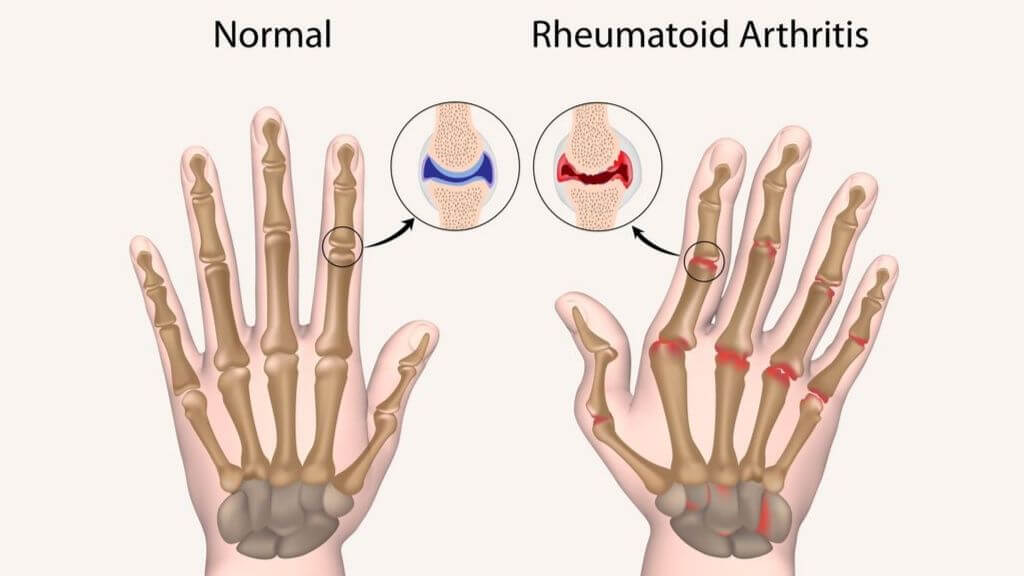Rheumatoid arthritis (RA) is an autoimmune condition in which your immune system mistakenly causes inflammation and damage to your joints.
This condition is very painful and disruptive to daily life. It occurs on both sides of the body, so the same joint on both sides will likely be affected. It is this symmetry that distinguishes it from other forms of arthritis.
Causes of Rheumatoid Arthritis
The exact cause of RA is unknown, but certain factors have been identified that increase your risk of developing RA. Women and those with a family history of RA are more at risk of developing the disease. Factors that are known to trigger the onset of RA include:
♦ Having a history of viral infections
♦ Smoking cigarettes
♦ Obesity
♦ Exposure to certain bacteria, such as those associated with periodontal disease
♦ Joint trauma or injury such as dislocation, breaks, or fractures
Rheumatoid Arthritis Symptoms
The symptoms of RA occur during periods known as flares, and when symptoms are not present, you are in a period of remission. RA symptoms can occur throughout the body and can be mild or severe. The most common symptoms include:
♦ Joint swelling
♦ Joint pain
♦ Joint stiffness
♦ Loss of joint function

Diagnosing Rheumatoid Arthritis
Multiple lab tests and a lot of time can be required to accurately diagnose RA. Your doctor will typically go through a series of testing to reach a diagnosis. Your symptoms and medical history are taken first, along with a physical examination of your joints. If they suspect RA, you will be referred to a specialist who will run a series of tests.
Blood tests are done to look for rheumatoid factor, antibodies associated with the disease, and chemicals present with inflammation.
Imaging tests such as x-rays and ultrasounds are done to identify joint damage and severity.
Treatment for Rheumatoid Arthritis
RA cannot be cured, but the symptoms can be reduced with the right treatment. Treatment for RA is designed to reduce inflammation and pain and to prevent joint damage.
There are a number of medications used to treat RA with some working to reduce flares and others limiting the damage done to joints. NSAIDs are most commonly used to relieve pain and swelling, but other prescribed medications can be used too.
♦ DMARDs (disease-modifying antirheumatic drugs) block your immune system response to slow the progression of RA.
♦ Biologics are the newest version of DMARDs, but instead of clocking the immune system, they block inflammation only.
♦ Janus kinase (JAK) inhibitors are used to prevent inflammation and stop joint damage but are only used when biologics and DMARDs are ineffective.

Rheumatoid Arthritis Diet
An anti-inflammatory diet is best for RA. By reducing inflammation, you can reduce the severity of symptoms and frequency of flares. An anti-inflammatory diet includes:
♦ Omega-3 fatty acids: These essential fatty acids are found in fatty fishes, chia seeds, walnuts, and flax seeds. You can also take supplements to ensure you are getting enough.
♦ Antioxidants: Vitamins A, C, and E are powerful antioxidants that work to reduce inflammation, and can be found in berries, spinach, kidney beans, artichokes, and dark chocolate.
♦ Fiber: Getting plenty of fiber in your diet helps to reduce inflammation, so eat more fresh vegetables, whole grains, and strawberries.
♦ Flavonoids: These beneficial compounds can be found in green tea, grapes, broccoli, berries, and soy products.
Natural Treatments for Rheumatoid Arthritis
Certain lifestyle changes and home remedies can be used to improve comfort and reduce pain.
♦ Get rest: Getting adequate sleep helps to reduce inflammation and can help with fatigue, which is common during flares.
♦ Exercise: Low-impact exercises are helpful for joint health and will increase mobility. Gentle exercises like yoga or swimming can strengthen joints and surrounding muscles, which will reduce the pressure each joint is exposed to.
♦ Go hot or cold: Cold compresses reduce pain and inflammation, and hot treatments such as baths or heating pads can reduce joint stiffness.
♦ Assistive devices: Using splints, braces, or crutches during flares can reduce the pressure placed on your joints and prevent unnecessary inflammation.

What Are the Variations of Rheumatoid Arthritis?
There are a few different types of RA, and knowing which you have is an important step in finding the most effective treatment.
♦ Seropositive RA: This type is marked by a positive rheumatoid factor test, which means you have antibodies causing your immune system to attack your joints. This version is not always confined to the joint and can impact your kidneys, nerves, lungs, heart, and blood vessels.
♦ Seronegative RA: After a negative rheumatoid factor test, you can still have RA symptoms. In some cases, you can develop antibodies over time, and your diagnosis will change to seropositive RA.
♦ Juvenile idiopathic arthritis: This is the term for RA in people younger than 17 years old. Symptoms are the same as other types of RA but also include eye inflammation.
Rheumatoid Arthritis Statistics
♦ Rheumatoid arthritis affects more than 1.3 million Americans and 1 percent of the world population.
♦ Women are more likely to develop the disease at a younger age than men.
♦ Rheumatoid arthritis typically develops between the ages of 30 and 60 years old.
♦ On average, symptoms do not appear until after the age of 60.
♦ Approximately 50,000 children in the United States have Juvenile RA.

Rheumatoid Arthritis and Children
Juvenile RA is caused by the immune system attacking healthy joints, just as it does with adults. Children have the same genetic tendencies as adults do for developing the condition.
Symptoms in children are similar to those in adults, but growth and development can also be stunted for children. Some joints can develop faster than others, resulting in different lengths in limbs and a shorter height.
Juvenile RA is treated with the goal of reducing development issues and preventing permanent joint damage.
What Is the Long-Term Outlook?
RA is a chronic condition with no cure, and painful and swollen joints can have a negative impact on your health and quality of life. In most cases, people with RA do not have constant symptoms, but flares can be debilitating when they occur.
The severity and the course of the disease will vary across people. Without treatment, joint problems can get worse and cause permanent damage, but with treatment, you can reduce inflammation and pain and maintain a healthy and happy life.






